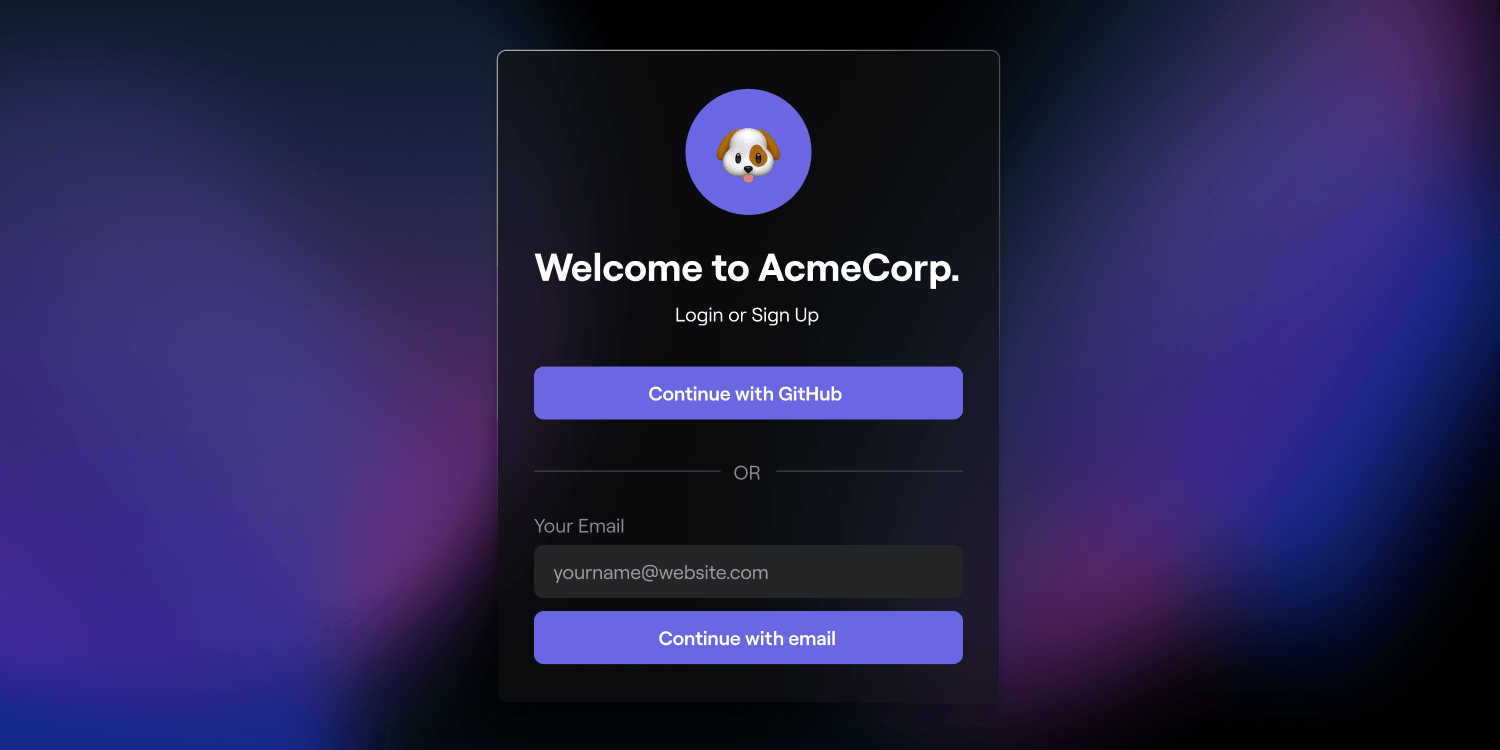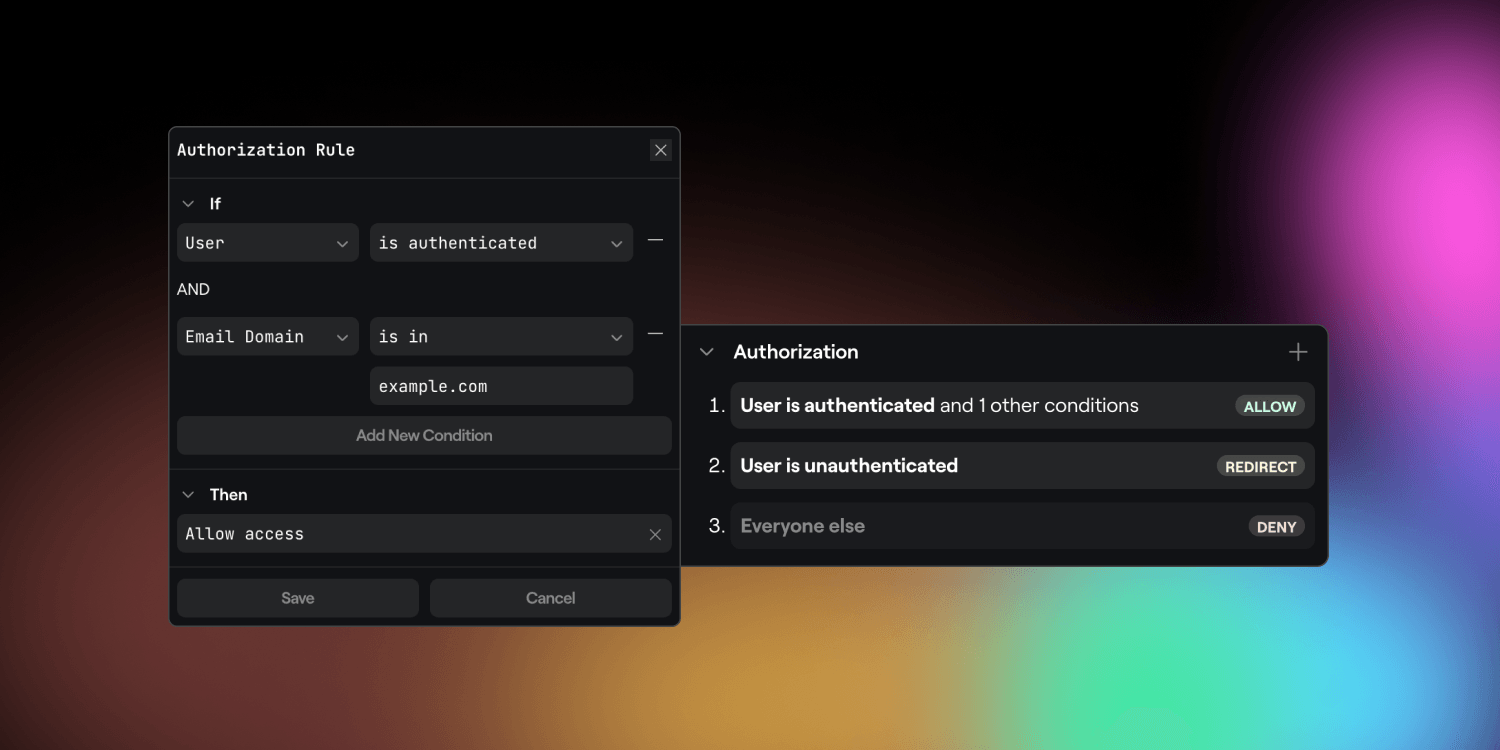Using Dynaboard’s code-forward WYSIWYG web app builder, quickly and easily build private apps that integrate seamlessly with your existing authentication providers. We offer flexible, usage-based pricing that affordably scales as both internal teams and external user bases grow.
Want to dive right in? Fork the private app boilerplate and get started in seconds.
Bring your own auth provider(s)

Dynaboard integrates directly with your existing authentication providers, so you can secure apps right away with no additional user accounts to create or manage. We support providers typically used for both internal and external (or end-user) identity management, including:
Any spec-compliant OIDC provider (e.g. Auth0)
If you’d like to get started even faster, we also offer our own email-based one-time PIN system that doesn’t require any external configuration. Users both internal and external to your company can securely log into your application with verified email addresses right away.
Fully customizable UI components

Dynaboard provides a pre-built login UI that can be fully styled with custom CSS to match your existing applications or brand styling. The sign-in component comes prebuilt with support for multi-step PIN authentication as well as event handlers that can be wired into any custom application logic. If you’d like to get a head start, you can copy our private app template (sign-in / sign-up required) or visit our documentation for a quick how-to guide.
Auth rules without the anxiety
The built-in auth rules and visual rule builder help reduce management overhead and potential configuration errors. Rules can be applied in a hierarchy to multiple parts of your application, including:
The sign-in flow (upon initial login)
The entire application, globally
Individual pages
(coming soon) Individual functions
Once you decide where you’d like a rule to apply, you can authorize users using premium or standard rules. Billing for active users is then based off of which rules were used to allow authorization for a given user in a particular month. The following rules can be used for authorization:
(Standard) The user is / is not authenticated
This rule ensures the user has authenticated with your app, and it can be used to redirect users to or away from a login page based on if they’re logged in.
Using this rule integrated with your own internal auth provider is a quick way to build applications that only allow your existing users / customers to login.
(Standard) The user has / doesn’t have a specific email address
If you have a small, mostly static, list of users that need to be authorized, they can be easily managed using this rule.
(Premium) The user’s email has / doesn’t have a specific domain
This rule allows you to restrict access to only users at your organization by specifying an allowed domain (e.g.
@example.com).
(coming soon / Premium) The user is / isn’t in a specific group on an auth provider
This rule can automatically gate certain parts of an application to users in a specific group (e.g.
administrators) and can be used with providers like: Google Workspace, Okta, GitHub, or Azure AD.
Easily build applications that adhere to the principle of least privilege, and with the addition of groups-based rules, ensure that access stays up to date with minimal ongoing effort.

Using this rule system, a customer support portal could easily offer multiple levels of access to different users, for example:
Gate access to a ticket submission page by the user Is Authenticated rule with your primary application serving as the auth provider with the custom OIDC resource. These would be standard users.
Only allow customer support agents to authenticate into the ticket queue via Google Workspace using the Has Domain rule with only authorized users that have a
@your-domain.comemail address. These would be premium users.Restrict the management overview page with the Is In Group rule to only authorize users who belong to the group
support-managers. These would be premium users.
Pay for active users, not empty seats
Dynaboard bills for the active users of your projects in a given month, and users are grouped by email across the entire workspace. For example, an internal user that logs into the customer support app and another internal dashboard would only be billed as a single user. Additionally, if they don’t login the following month, they’re automatically removed from your bill. With Dynaboard there is no per-developer pricing and no per-seat licenses, so you only pay for the actual usage and users of your application.
Standard users start at $0.20 per additional monthly user on the individual plan and $0.25 on the team plan, while premium users start at $10 per additional monthly user on the Team plan. To see a full list of pricing and features checkout our pricing calculator.
Getting started
If you’d like to get started building your own private apps, you can sign-up for Dynaboard, copy our prebuilt private app template (sign-in / sign-up required), test the live demo, or learn more about building apps from our documentation.


